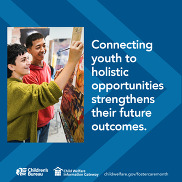
Child welfare agencies are responsible for promoting the healthy development and well-being of children and young people in their care. To achieve healthy development, children and young people in foster care need to be involved in normal and developmentally appropriate extracurricular and social experiences, commonly referred to as normalcy.
-
“Normalcy” refers to allowing young people in out-of-home care to experience childhood and adolescence in ways similar to their peers who are not in foster care. This includes participating in various social and cultural activities such as after-school clubs, sports, community events, school field trips, sleepovers, social media; getting a job; taking driver's education courses; attending dances; going to movies with friends; and more.
-
“Reasonable and prudent parent standard” is a term used in federal and state legislation that refers to practical decision-making of foster parents and other caregivers in allowing children and young people in foster care to participate in healthy and developmentally appropriate activities. The term "normalcy" is often used to reflect the legislative intent of implementing a reasonable and prudent parent standard.1
Young people are better able to achieve normalcy when child welfare agencies engage them in regular permanency planning, listen to their needs in care and goals for the future, connect them to support services and developmentally appropriate experiences, and help them maintain and establish new long-term relationships.
|
Engaging Youth & Young Adults
Youth and young adults are experts on their own lives.2 Child welfare agencies are required to ensure children in foster care age 14 or older participate in the development or modification/adjustment of case plans.3 By engaging young people in permanency planning so that they can make their own informed decisions around what services they need and which relationships and activities they want to engage in, agencies can set young people up to thrive when they exit foster care.
Building Supports & Strengthening Opportunities
For young people in foster care, especially those transitioning out of care without permanent family connections, state-funded and federally funded services can help bridge the gap between stability and instability. Supports should be culturally responsive and in tune with the unique challenges older youth/young adults must overcome when they enter, experience, and exit the foster care system.5 Connecting young people to services, events, and opportunities is another critical way to support young people in their communities.
Young people engaged with the child welfare system don’t stop needing support when they turn 18. Extended foster care programs are designed to allow young people to remain in or reenter care, providing them with more time to adjust to independent living with support from adults. Extended foster care resources vary from state to state but are designed to help young adults meet a variety of needs. Both extended foster care and transitional services may include meeting housing needs, providing affordable housing, or providing transportation support, tuition or continuing education assistance, career and employment coaching, health care access, life skills, and more.6 Explore these topics with young people prior to their transition into adulthood so they have ownership in their transition and control in meeting their needs.
According to a 2019 study by Child Trends, young people who received extended care, as opposed to those who exited foster care at the age of 18, are:
 Source: Rosenbeg, Rachel and Abbott, Samuel. (2019). Supporting older youth beyond age 18: Examining data and trends in extended foster care. Child Trends
Child welfare agencies should continue to offer and extend services to implement support that ease transitions out of care and set young people up for long-term success. Check out our John H. Chafee Foster Care for Successful Transition to Adulthood Program Resource List for more ideas on how child welfare agencies can partner with young people to support their transitional needs.

This year's National Foster Care Month (NFCM) theme—“Engaging Youth. Building Supports. Strengthening Opportunities.”—focuses on the needs of young people transitioning out of foster care into adulthood and independent living. To ensure that children and young people have a better chance of normalcy and future success, child welfare professionals should engage them in permanency planning, help them nurture important relationships, and provide them access to culturally appropriate resources and opportunities.
Use the Child Welfare Information Gateway’s (Information Gateway’s) NFCM resource collection and outreach toolkit to help the public and professionals learn more about the diverse needs of young people exiting foster care and the benefits of having normalcy conversations early and continuously throughout a young person’s time in foster care.
|
The Center has several resources to help agencies engage young people in normalcy conversations and provide holistic supports and services.
Center Resources
Related Resources
Did you receive this message from a friend? Get it delivered to your inbox.
|